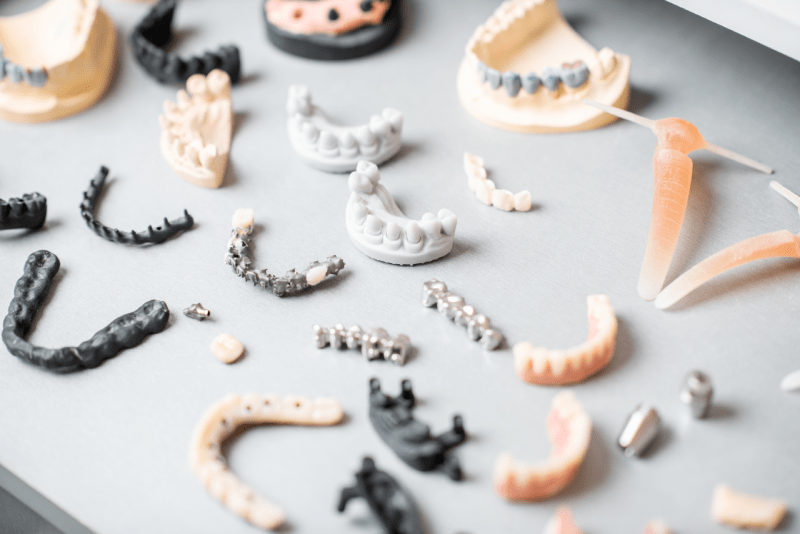Introduction: Rediscover Your Smile
Your smile is one of the most important parts of your personal image. Over the years, stains, chips, cracks, or misshapen teeth can negatively affect your self-confidence. Modern dentistry offers permanent and aesthetic solutions to these problems. At the forefront of these solutions are dental veneers, which are aesthetic restorations made of thin, custom-designed porcelain or composite materials applied to the front surface of your teeth. In this guide, we will examine in detail all the stages of the veneer process, who it is suitable for, and what you need to pay attention to for the best results.
What Are Dental Veneers?
A dental veneer is an extremely thin, custom-made covering that is permanently bonded to the front surface of teeth. Typically made of porcelain or composite resin, these coverings are used to improve the color, shape, size, and alignment of teeth. Porcelain veneers, with their high light translucency, offer an aesthetic similar to natural tooth enamel. Composite veneers are a faster and often more affordable alternative. Veneers are an effective method not only for aesthetic purposes but also for repairing small chips, cracks, or closing gaps between teeth.
Who Are Veneers For?
Dental veneers are an ideal solution for individuals with a variety of aesthetic concerns. The main suitability criteria are as follows:
- Discoloration: Teeth with stubborn stains that do not respond to bleaching.
- Small Cracks and Chips: Repairing minor cracks or chips on the front surface of teeth.
- Gaps Between Teeth: Closing spaces (diastema) between teeth.
- Misshapen Teeth: Correcting teeth that are unusually short, pointed, or asymmetrical.
- Minor Alignment Issues: Improving the appearance of slightly crooked or misaligned teeth.
However, patients with serious gum disease, teeth grinding (bruxism), or extensive decay must first have these underlying issues treated. Additionally, if the tooth structure is severely worn down, veneers may not be suitable, and alternative treatments should be considered.
Types of Dental Veneers
There are two main types of dental veneers: porcelain and composite. Both have their own unique advantages and disadvantages.
Porcelain Veneers
Porcelain veneers are thin layers of porcelain custom-made in a laboratory setting. Porcelain is highly popular due to its ability to mimic the natural aesthetics of tooth enamel, reflecting and transmitting light. Porcelain veneers are highly resistant to staining and are very durable. The process typically requires more than one appointment.
Composite Veneers
Composite veneers are made from a tooth-colored resin material that is applied directly to the tooth by the dentist in the office. This procedure can usually be completed in a single appointment. Composite veneers are more affordable than porcelain but are more susceptible to staining and generally have a shorter lifespan. They are an ideal option for minor corrections.

Veneers vs. Crowns
Dental veneers and crowns (full coverings) are two different treatment methods frequently used in aesthetic and restorative dentistry. The most fundamental difference is how much of the tooth is covered. Veneers cover only the front surface of the tooth, while crowns encircle and completely cover the entire tooth. Crowns are usually preferred for more severe tooth damage, such as large cavities, fractures, or weakened teeth. Veneers, on the other hand, are a treatment primarily for aesthetic purposes and aim to preserve the healthy structure of the tooth.
The Veneer Process: The First Step is Consultation
Your dental veneer journey begins with a comprehensive consultation with a dentist. In this first appointment, your dentist will evaluate your oral health, listen to your aesthetic expectations, and determine if veneers are a suitable option for you. The general condition of your teeth and gums will be examined, X-rays may be taken, and a treatment plan will be created. This phase is one of the most critical steps in the entire process, as proper planning is the key to achieving excellent results.
Tooth Analysis and Smile Design
Following the consultation, your dentist will create a smile design. In this phase, a special plan is made considering the patient’s facial features, lip shape, current dental condition, and personal expectations. Digital Smile Design (DSD) technology can be used to create a simulation of the patient’s future smile. This allows the patient to see what the final result will look like beforehand and give their approval before starting the treatment. This strengthens communication between the patient and the dentist and clarifies expectations.
Preparation Phase: Shaping the Teeth
For porcelain veneers, the next step is the minimal reduction of the front surface of the teeth. This procedure is done to ensure the veneers fit perfectly on the teeth and achieve a natural look. The dentist removes only about half a millimeter or less of the tooth enamel. This stage is generally painless, but local anesthesia can be applied for the patient’s comfort. For composite veneers, this stage is usually not necessary.
Impressions and Temporary Veneers
After the teeth are prepared, the dentist takes precise impressions or uses a digital scanner to create a model of your teeth. These impressions are sent to a laboratory to produce your custom porcelain veneers. This process can take several days. During this waiting period, temporary veneers are placed to protect the sensitivity and aesthetic appearance of your teeth.
Laboratory Process: Veneer Fabrication
Laboratory technicians meticulously produce the veneers according to the impressions and the dentist’s instructions. In this phase, the color, shape, and size of the veneers are adjusted down to the finest detail to match the patient’s other teeth. Porcelain veneers are produced with high-quality materials and state-of-the-art firing techniques to achieve maximum durability and aesthetics. This process can typically take one to two weeks.
Application Phase: Veneer Placement
When the veneers arrive from the laboratory, the patient is called in for a second appointment. The dentist performs a final trial placement before permanently bonding the veneers to the teeth. During this trial phase, the color and shape of the veneers are checked again. Once everything is confirmed, the tooth surface is prepared with a special adhesive, and the veneers are carefully placed on the teeth. This bonding process is hardened with a strong light, ensuring the veneers are securely attached to the tooth.
Final Checks and Fit Test
After the veneers are bonded to the teeth, the dentist performs a final check. Excess adhesive is cleaned, the fit of the veneers with the gums is checked, and your bite (occlusion) is adjusted. This stage is vital for comfortable chewing function and a natural appearance.
Post-Application Care
Although veneers are durable, careful use and maintenance are required for them to last a long time. In the first few days after application, it is beneficial to avoid very hot or cold foods and to be careful while chewing. It is also important to avoid habits such as nail-biting or pen chewing. Patients with teeth-grinding habits are advised to use a night guard to prevent damage to the veneers.
Veneer Care: Tips for Longevity
Regular and proper care is essential to use your dental veneers for a long time.
- Regular Brushing: Brush your teeth at least twice a day with a soft brush and fluoride toothpaste.
- Use of Dental Floss: Do not neglect to use dental floss to clean plaque and food particles between your teeth.
- Regular Dental Check-ups: Visit your dentist at least twice a year to check the general condition of your veneers and oral health.
- Avoid Staining Foods: Although porcelain veneers are resistant to staining, excessive consumption of staining foods such as coffee, tea, and red wine can lead to color changes in the long run.

Advantages of Veneer Application
- Natural Appearance: Porcelain veneers reflect light like natural tooth enamel and offer an extremely natural aesthetic.
- Durability: Porcelain veneers are highly resistant to staining and wear.
- Minimal Tooth Reduction: A minimal amount of tooth reduction is sufficient for the application.
- Fast Results: The process is usually completed in a few appointments, providing a quick change in your smile.
Potential Disadvantages and Risks
- Irreversible Procedure: Since a minimal amount of tooth enamel is removed, the procedure is irreversible.
- High Cost: Porcelain veneers are more expensive than composite veneers.
- Risk of Chipping: Biting very hard foods or putting excessive pressure on the teeth can cause chipping.
- Tooth Sensitivity: Temporary sensitivity may be experienced after the procedure.
Lifespan and Durability of Veneers
Porcelain veneers can last 10 to 15 years, or even longer, with good care. The lifespan of composite veneers is usually between 5 and 7 years. This period varies depending on oral hygiene, regular dental check-ups, and usage habits.
Pain and Discomfort
Pain is generally not felt during the veneer procedure because the dentist uses local anesthesia. After the procedure, there may be a slight sensitivity or pain, but this resolves on its own within a few days. If necessary, your dentist may recommend a pain reliever.
How Long Does the Veneer Process Take?
The porcelain veneer application is usually completed in two or three appointments.
- First Appointment: Consultation and teeth preparation (1-2 hours).
- Second Appointment (1-2 weeks later): Veneer placement (1-2 hours). The composite veneer application, on the other hand, can be completed in a single appointment, usually within 1 to 3 hours.
Factors Affecting Veneer Cost
Veneer costs vary depending on many factors. These include:
- Material Type: Porcelain veneers are more expensive than composite veneers.
- Number of Teeth to be Treated: The cost increases as the number of veneers to be applied increases.
- Dentist’s Experience and Clinic Location: The prices of an experienced dentist and a clinic with modern equipment may differ.
- Necessary Additional Treatments: If additional treatments such as fillings or root canals are needed beforehand, this may be reflected in the cost.
Can Veneers Be Replaced?
Yes, veneers can be replaced when they are worn out, chipped, or when the patient desires a new aesthetic. The old veneers are gently removed, and the teeth are prepared again for the new coverings. This makes it possible to refresh your smile.
How to Achieve a Natural Look?
Achieving a natural look is one of the most important goals of a veneer application. This requires proper planning, quality materials, and an experienced dentist. Porcelain veneers are produced to mimic the translucency and color variations of natural teeth. Ensuring the smile design is in harmony with facial features and other teeth prevents the result from looking artificial.
The Change in Your Smile: Psychological Effects
Having an aesthetic smile not only enhances your appearance but also boosts your self-confidence. A veneer application can help a person smile more comfortably in social settings, speak more freely, and feel better about themselves. This can have positive psychological effects on daily quality of life.
Choosing the Right Clinic for a Successful Application
The veneer procedure requires both artistic and technical skill. Therefore, it is very important to choose an experienced and reliable dentist. Examining the dentist’s previous patient work and researching the technology and materials used by the clinic will help you make the right decision.
Renew Your Smile with Cure Holiday
Remaking your smile is an important decision, and you’ll want to work with an expert team throughout the process. Cure Holiday offers high-quality services in the field of aesthetic dentistry. With experienced dentists, state-of-the-art equipment, and personalized treatment plans, we help you achieve the smile you’ve always dreamed of.
If you also want to renew your smile and receive the best dental veneer services, you can contact Cure Holiday for more information and a consultation appointment. Our expert team is ready to create a personalized smile design for you and answer all your questions. The smile of your dreams is just a step away!



